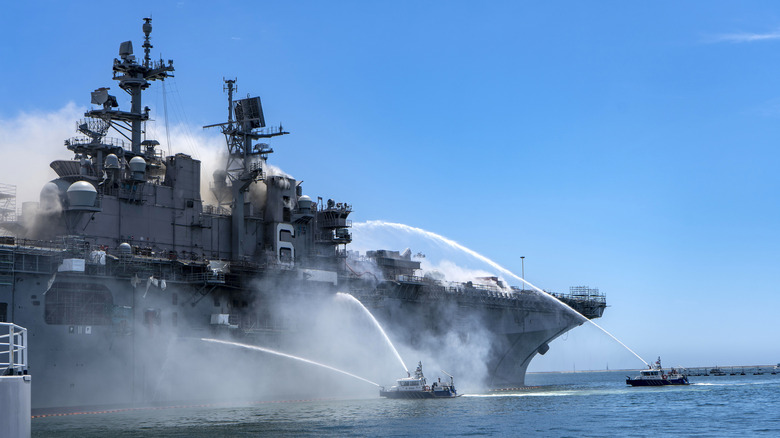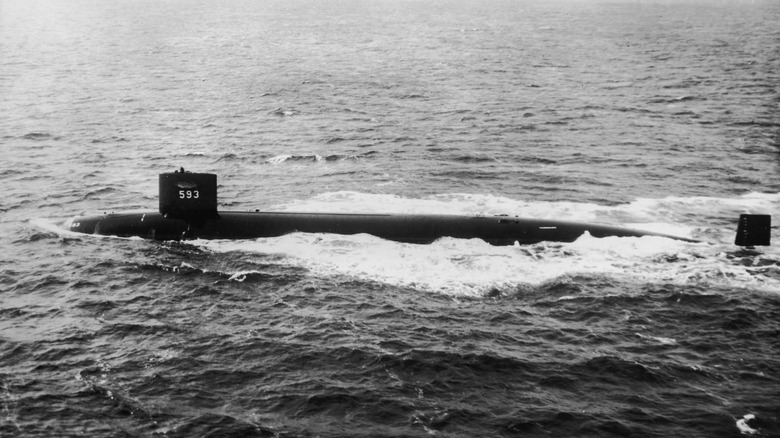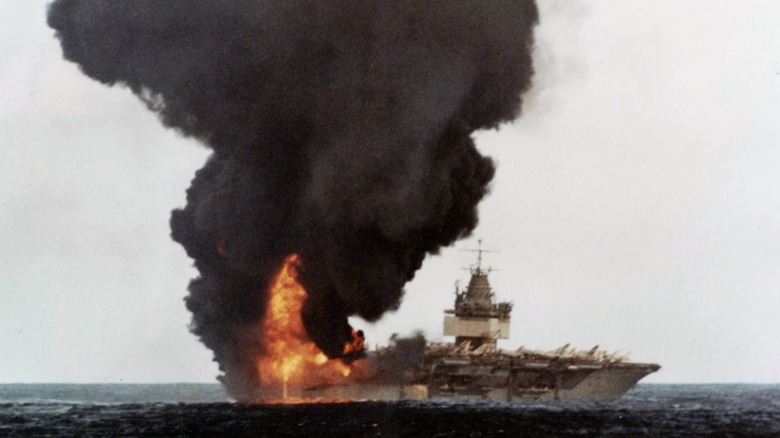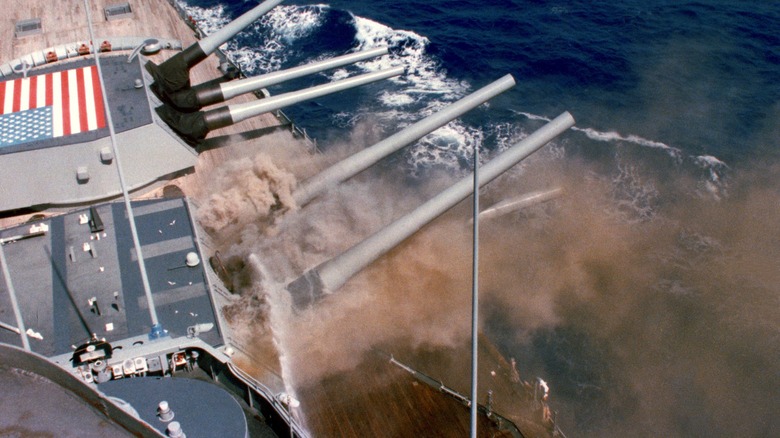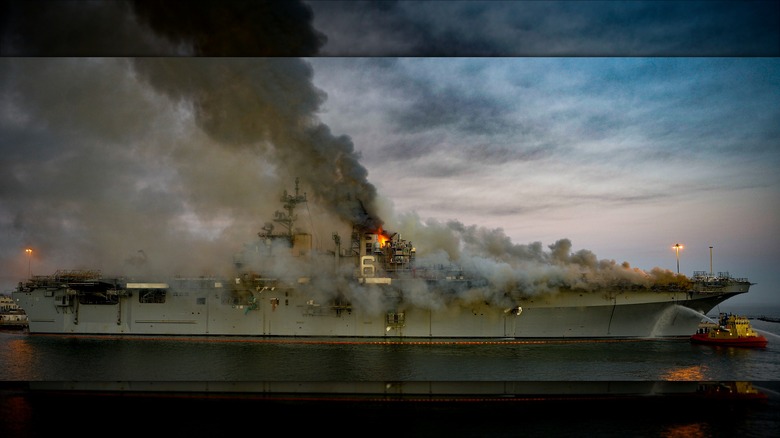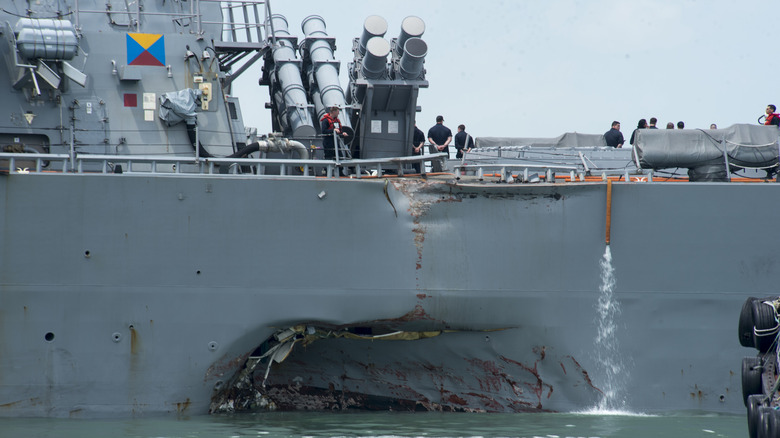The 5 Worst Non-Combat Accidents To Befall US Navy Ships
If there's one thing on every sailor's mind while aboard a ship or boat, it's safety and avoiding accidents. After all, a misplaced cigarette butt can be the difference between a career filled with exceptional service and a fire that destroys half the ship. That happened in 2008 to the USS George Washington aircraft carrier. Accidents aboard ships are often deadly, and every sailor has that drilled into their heads from the day they start their training.
While the U.S. has lost numerous vessels in combat operations since its founding, there have been thousands of accidents during peacetime operations. Whether one vessel slams into another, there's an otherwise avoidable fire, or a plane misses its landing on a carrier and causes widespread damage — odds are, it's going to be bad. Accidental explosions, running aground, and other mishaps have plagued U.S. Navy vessels for years, and some ships have been lost as a result.
Of course, with thousands of examples, the worst non-combat accidents related to U.S. Navy ships are difficult to ascertain. "Worst" could apply to the financial cost, the lives lost, or both, and since these things happen somewhat periodically, this article is looking back no further than the 1960s. Since that time, there have been significant ship losses and widespread damage, reducing the Navy's combat effectiveness while costing the lives of many service members. These are the worst naval accidents to occur, arranged chronologically.
The implosion of the USS Thresher
The USS Thresher (SSN-593) was a nuclear attack submarine commissioned in August 1961. The boat was designed to hunt for and kill Soviet subs, and she was outfitted with all the bells and whistles of the era to make her fully mission-capable. The sub was relatively light, displacing 3,700 tons of seawater at the surface with a crew complement of 16 officers and 96 enlisted personnel. Sadly, all hands were lost on April 10, 1963, when the Thresher sank below crushing depth.
At the time of the sinking, the Thresher had recently completed her sea trials and was conducting a deep-diving test alongside the USS Skylark (ASR-20). The vessels were operating about 220 miles outside of Massachusetts, and it became clear relatively quickly that there was a problem. The Skylark received communications that ended abruptly after sometime around 9 A.M. EST. The ensuing investigation found that all 129 officers, civilian contractors working during the trial, and enlisted crewmen were lost when the vessel failed for unknown reasons.
The boat likely lost power and was unable to blow her ballast tanks, which would have allowed her to return to the surface rapidly. Instead, she continued to sink until reaching the bottom, 8,400 feet below the surface. Decades after the accident that cost the Navy 129 lives and a new nuclear-powered submarine, there are still no definitive answers as to what caused the sinking of the Thresher. Whatever the truth, the loss of the Thresher is one of the worst non-combat accidents to befall a U.S. Navy vessel.
The USS Enterprise's deck explosion killed 28 sailors and injured hundreds
The U.S. Navy has a tradition of naming its aircraft carriers "Enterprise," and a terrible accident occurred on the second carrier to bear the name. The USS Enterprise (CVAN-65) was also the first nuclear-powered aircraft carrier, so she has an extensive history. That history includes one of the deadliest deck fires to occur on a U.S. aircraft carrier during peacetime operations. Granted, she was preparing to deploy to Vietnam at the time, but she was off the coast of Hawaii when tragedy struck.
In preparation for her deployment, the crew was undergoing flight operations involving several fully-fueled aircraft. An aircraft starter unit was placed too close to an exhaust port, too close to a Mk. 32 five-inch Zuni rocket. The warhead cooked off in 78 seconds, and it wasn't the only thing to explode. Several aircraft, six Mk. 82 500-lb. bombs and plenty more went up in flames, engulfing the ship's bow in a massive conflagration.
The flames caused widespread damage and resulted in the deaths of 28 sailors. An additional 314 personnel were injured, 17 aircraft were damaged, and another 15 were lost. The repairs and replacement aircraft cost $126 million, amounting to $1.08 billion in 2024. While terrible, the accident could have been worse. A 1967 fire on the USS Forrestal created the lessons learned needed to save future vessels. More Enterprise sailors were trained in firefighting, likely lessening the damage.
[Featured image by U.S. Navy via Wikimedia Commons | Cropped and scaled | Public Domain]
The USS Iowa's turret explosion killed 47 sailors
The USS Iowa (BB-61) is one of the most legendary ships of World War II, and she was the last of any class Battleship to serve in the U.S. Navy. The Iowa was commissioned in 1943, but these days, she's a museum ship located at the Port of Los Angeles. In 1989, she was the site of a massive deck explosion. On April 19, 1989, the Iowa was preparing for a live-fire exercise at Vieques, Puerto Rico Naval Training Range, when disaster struck.
The ship's Turret 2 had a problem reported, and within two minutes, a massive fire broke out. Sailors tried to put it out, but before that could happen, a massive explosion rocked the ship. Turret 2 exploded, killing 47 crewmen working within and severely damaging the turret. The initial investigation blamed Gunner's Mate 2nd Class Clayton Hartwig, who died in the explosion. The accusations were unsubstantiated, and the Navy backed away from this, apologizing to his family.
The Navy never settled on a cause for the accident, though numerous theories arose. A second investigation was also inconclusive, so decades later, it's still unknown how the fire that caused the explosion began. The damage caused by the explosion and the fact that the Navy was already moving away from battleships spelled the end of service for the Iowa. She was decommissioned in October of the following year, conclusively ending the era of battleships.
[Featured image by U.S. Navy via Wikimedia Commons | Cropped and scaled | Public Domain]
The USS Bonhomme Richard fire injured dozens and destroyed the ship
The USS Bonhomme Richard (LHD-6) was a Wasp-class amphibious assault ship that was commissioned in 1998. She served as a sort of light aircraft carrier capable of delivering a Marine Corps amphibious assault force via helicopters, amphibious vehicles, and landing craft. The Bonhomme Richard served for over two decades, but her service ended after a fire broke out on a low deck on July 12, 2020.
While docked at Naval Base San Diego for maintenance, a fire erupted, and it took the Navy four days to put it out. Naval helicopters delivered over 1,500 water buckets as tug boats sprayed water to try and drown the flames. The Navy charged sailor Ryan Sawyer Mays for starting the fire, and though it took two years for the case to be fully adjudicated, he was acquitted of all charges, though several higher-ups weren't as fortunate.
As often happens in these situations, the people on top took the brunt of responsibility. The ship's commander, executive officer, and senior enlisted sailor were all found guilty of violating Article 92 of the Uniform Code of Military Justice (UCMJ) — failure to obey an order or regulation as it related to widespread safety failures aboard the ship. As for the Bonhomme Richard herself, she was stricken and sold for scrap, as it would have cost more than $3 billion and up to seven years to repair her back to fully working order.
[Featured image by U.S. Navy via Wikimedia Commons | Cropped and scaled | Public Domain]
The USS John S. McCain collision killed ten sailors
Navy vessels have a great deal of mass, so it's usually a very bad idea to have two of them collide with one another. This was never more clear to a group of sailors than the ones aboard the USS John S. McCain (DDG-56) in 2017. The McCain is an Arleigh Burke-class destroyer first commissioned in 1994. On August 21, 2017, she was involved in a collision with the Alnic MC, a Liberian tanker, off the coast of Singapore.
The collision was the result of a steering failure, though it's unclear why McCain's backup steering system wasn't used. Unable to turn fast enough, the McCain slammed into the 600-foot-long oil tanker, causing massive damage to herself. The warship immediately began taking on water as several compartments flooded, including crew berths, resulting in the deaths of ten sailors. All of the sailor's bodies were recovered, and while the McCain was able to limp away to seek repairs – it was out of the fight for almost three years.
The repairs weren't cheap, costing $223 million, with initial estimates putting a timeline of one year to get it done. A month before the McCain collided as it did, the USS Fitzgerald (DDG-62) had a similar accident, resulting in the loss of seven sailors. The cost to repair that vessel was significantly higher, at somewhere around $327 million, according to a Navy estimate. These accidents and the many thousands not mentioned cost the Navy valuable personnel and equipment, and each of them occurred outside of combat operations.
